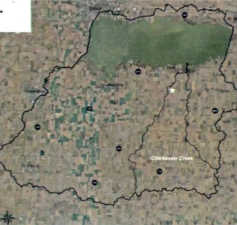
The Ohio Department of Agriculture is proposing that the manure ban in the Grand Lake Watershed be lifted and producers be allowed to spread manure at all times of the year. This would replace the current rule, implemented in 2011, that prohibits manure spreading from Dec. 15 to March 1.
The link to this proposed legislation change is listed below:
It is the opinion of the Lake Improvement Association that this new set of standards being proposed is an effort by ODA to have uniformity for both the Western Lake Erie basin as well as The Grand Lake Watershed.
On behalf of the thousands of members and concerned citizens that The Lake Improvement Association represents, we feel that any changes that complicate manure spreading rules in our watershed at this time would be reckless and unfounded given the advances that have been made in decreasing nutrients from fields. This progress our producers have made in nutrient reduction is detailed in Dr. Steven Jacqeumin’s published research here:
https://dl.sciencesocieties.org/publications/jeq/pdfs/47/1/113?search-result=1
With this in mind, the Lake Improvement Association vehemently opposes the proposed changes in the distressed watershed package for Grand Lake St. Marys.
Furthermore, the proposed rule changes were drafted, voted on, and listed for public comment without contacting any individuals who are dealing with the watershed on a daily basis at the local level. Additionally, this new package was quietly released on a Friday before a holiday weekend with only a 7-day window for public comment. We find this unbecoming as it seems like an attempt to skirt public reaction.
The Lake Improvement Association requests that these questions be answered immediately :
- There is published data to prove that our current watershed rules are decreasing nutrients leaving fields in the GLSM watershed. Do you (ODA) have equivalent data to prove that these rule changes will be equally or more effective than the current rule set?
- Is it possible to keep the current manure ban and add the chemical fertilizer, weather provisions, and application practices in the new proposal for the GLSM distressed watershed package?
- Does ODA feel that these new proposals are realistically enforceable?
- If yes, what has changed since the last distressed watershed package was issued? The manure ban was put into place, as it was the only viable plan that provided realistic enforcement opportunities.
Please voice your opposition to the proposed manure changes by Sept. 7, 2018, by emailing AGReComments@agri.ohio.gov. That is the email address for public comments, and the most critical action you can take today. In addition, please consider emailing your representatives. You can do so via https://democracy.io and https://www.house.gov/representatives/find-your-representative.
You can copy the following template:
Dear Ohio Dept. of Agriculture,
I am writing to oppose OAC 901:13-1-19 and the proposed change to manure spreading rules in a distressed watershed. Since 2011, the Dec. 15 to March 15 ban on manure spreading has played a vital role in reducing excess nutrients that cause toxic algae blooms in Grand Lake St. Marys.
Research published by Dr. Steven Jacquemin has proven the efficacy of the manure ban and progress made by producers in the Grand Lake St. Marys watershed. To lift this ban now would be reckless and unfounded given the advances that have been made in decreasing nutrients that pollute the watershed.
Before any such changes are considered, the following questions must be answered:
- There is published data to prove that our current watershed rules are decreasing nutrients leaving fields in the GLSM watershed. Do you (ODA) have equivalent data to prove that these rule changes will be equally or more effective than the current rule set?
- Is it possible to keep the current manure ban and add the chemical fertilizer, weather provisions, and application practices in the new proposal for the GLSM distressed watershed package?
- Does ODA feel that these new proposals are realistically enforceable?
- If yes, what has changed since the last distressed watershed package was issued? The manure ban was put into place, as it was the only viable plan that provided realistic enforcement opportunities.
Sincerely,
Your Name
